#1. capitalism 2. christianity 3. the roman empire
Explore tagged Tumblr posts
Text
My Roman Empire is actually the Roman Empire
#obviously am a man after all#look like the roman empire had a major effect on history and our western culture#every thing in society can be blamed on:#1. capitalism 2. christianity 3. the roman empire
0 notes
Text
Discover Turkey: A Journey Through Culture, Cuisine, and History
Turkey is a captivating destination where history, culture, and cuisine come together to create a rich and immersive experience. As a country that bridges Europe and Asia, Turkey offers a unique blend of ancient traditions and modern charm. From the bustling bazaars of Istanbul to the ancient ruins of Ephesus and the surreal landscapes of Cappadocia, there’s something for every traveler to explore. Whether you're a history enthusiast, a foodie, or simply seeking adventure, Turkey has it all. With a variety of Turkey tour packages available, you can easily plan your journey and experience the best that this diverse and vibrant country has to offer. Discover Turkey and embark on an unforgettable journey through its culture, cuisine, and history.

Here are some excerpts from Discover Turkey: A Journey Through Culture, Cuisine, and History.
1.Overview of Turkey: A Culturally Rich and Diverse Nation:

Turkey is a distinct example of an East-West fusion nation situated between two continents. It is one of the most fascinating travel destinations in the world because of its deep-rooted history, varied landscapes, and rich cultural heritage. Turkey offers visitors a wide range of experiences, from the busy streets of Istanbul to the historic ruins of Ephesus. The nation's rich history as a crossroads of civilizations is reflected in its diversified culture. Turkey offers something for everyone, whether you are an adventurer, a foodie, or a history enthusiast.
2. Istanbul as a Cultural Melting Pot:

The largest city in Turkey, Istanbul, is frequently seen as the center of the nation's cultural identity. The Roman, Byzantine, and Ottoman empires all had Istanbul as their capital. Originally called Byzantium, it was subsequently renamed Constantinople. The beautiful Hagia Sophia and the Topkapi Palace are just two examples of the city's architectural design that reflect its historical significance. You can sense the melting pot of cultures and the pulse of history as you stroll through Istanbul's streets. Turkish culture may be thoroughly experienced in the city's bustling bazaars, diversified neighborhood like Sultanahmet and Beyoğlu, and active arts scene.
3. Turkish Cuisine: A Taste of Culinary Delights:

With its vibrant colours, fragrant spices, and variety of dishes that honour the nation's ethnic past, Turkish food is a sensory feast. A synthesis of elements from the Middle East, Mediterranean, Balkan, and Central Asia has shaped the cuisine. A trip to Turkey wouldn't be complete without sampling its delectable cuisine. Enjoy a classic Turkish breakfast consisting of eggs, fresh bread, cheeses, and olives to start your day. Don't pass up traditional foods like pide (Turkish pizza), mezes (small appetizers), and kebabs. The nation is renowned for its desserts as well, especially baklava, a pastry consisting of layers of filo dough stuffed with nuts and covered in honey. Try a glass of Turkish tea or coffee to go with your meal—both are essential components of Turkish hospitality.
4. Revealing the Historical Treasures of Turkey:

Turkey is a historical treasure trove, with ruins of long-gone civilizations all around the nation. Ephesus, an ancient Greek city on the Ionian shore, is one of the most well-known. It is home to the Temple of Artemis, one of the Seven Wonders of the Ancient World. With its ancient remains, the city of Troy—immortalized in Homer's epic poems—offers a window into the past. Because early Christians lived in Cappadocia and carved churches and monasteries into the rock formations, the region has great historical and cultural significance in addition to its bizarre landscapes of fairy chimneys and underground cities. By visiting these locations, tourists can travel back in time and take in the magnificence of the civilizations that formerly called this area home.
5. Turkey's Natural Wonders:
Turkey has some amazing natural scenery in addition to its cultural and historical value. The Turkish name Pamukkale, which translates to "Cotton Castle," is a marvel of nature with its white travertine pool terraces that are full of mineral-rich water. For thousands of years, people have used these hot springs for therapeutic purposes. The breathtaking turquoise coast, where the Aegean and Mediterranean waters converge, is yet another wonder of nature. The beaches of Fethiye, Bodrum, and Antalya are ideal for leisurely walks and aquatic activities. Hikers who love the great outdoors can enjoy breathtaking views of the sea and mountains from the Lycian Way, a long-distance hiking track that runs along the coast. There are countless options for adventure due to the country's diversified topography, which ranges from the rich plains of Anatolia to the untamed mountains of the East.
6. Turkish Hospitality: You're Invited to Stay Here:
The friendliness and kindness of the Turkish people are among the most unforgettable experiences of travel there. Turkish people are renowned for their warm hospitality, always going above and beyond to make guests feel at home. The generosity of Turkish people is apparent everywhere, whether you are asked into a home for a cup of tea or are helped by a stranger on the street. The nation's culture and customs, which uphold the highest standards of care and respect for visitors, are firmly ingrained in the concept of hospitality. Interacting with the people, picking up a few Turkish phrases, and taking part in cultural practices like dining together or going to a festival can all significantly enhance your trip.
Conclusion
Turkey is a destination that promises a rich blend of culture, history, and culinary delights. Whether you’re exploring the ancient ruins of Ephesus, savouring authentic Turkish cuisine, or soaking in the breathtaking landscapes of Cappadocia, every moment in Turkey is filled with discovery. The country's unique position at the crossroads of continents makes it a melting pot of traditions and influences, offering something for every traveler. With a variety of Turkey holiday packages available, planning your journey is easier than ever. These packages allow you to experience the best of Turkey, ensuring a memorable adventure that captures the essence of this extraordinary country.
0 notes
Text
Rome Through The Years - A Historical Escapade
"Rome Through The Years - A Historical Escapade" is a captivating journey through the rich and diverse history of Rome, Italy's capital city. Rome's history spans over 2,000 years, making it one of the most historically significant and culturally influential cities in the world. This historical escapade will take you through some of the key periods and events that have shaped Rome into the magnificent city it is today.
1. Ancient Rome (c. 753 BC - 476 AD): Our journey begins with the legendary founding of Rome in 753 BC. The ancient Romans built a powerful and enduring civilization that left a lasting legacy in architecture, engineering, law, and governance. Explore iconic landmarks such as the Colosseum, Roman Forum, and Pantheon, which stand as testaments to the grandeur of ancient Rome.
2. The Roman Republic (509 BC - 27 BC): This period witnessed the establishment of the Roman Republic, a complex system of government characterized by the Senate and the popular assemblies. Notable figures like Julius Caesar and Cicero played pivotal roles during this era.
3. The Roman Empire (27 BC - 476 AD): The rise of Augustus marked the transition from the Republic to the Roman Empire. Under the rule of emperors like Trajan and Hadrian, the empire expanded to its greatest territorial extent. The Pax Romana (Roman Peace) brought stability, and Roman law and culture spread throughout Europe and beyond.
4. The Decline and Fall of the Western Roman Empire (3rd century - 476 AD): Witness the gradual decline of the Western Roman Empire due to internal strife, economic challenges, and external threats from barbarian invasions. In 476 AD, the last Roman emperor, Romulus Augustus, was deposed, marking the end of the Western Roman Empire.
5. The Byzantine Empire (4th century - 1453 AD): While the Western Roman Empire fell, the Eastern Roman Empire, known as the Byzantine Empire, endured for nearly a millennium. Discover the Byzantine influence on Rome, including the construction of iconic structures like the Hagia Sophia.
6. The Middle Ages (5th century - 15th century AD): Explore the medieval period in Rome, marked by the rise of Christianity, the Papal States, and the construction of awe-inspiring churches like St. Peter's Basilica and the Sistine Chapel.
7. The Renaissance (14th century - 17th century AD): Witness the rebirth of classical learning and the flourishing of art and culture during the Renaissance. The papal patronage of artists like Michelangelo and Raphael transformed Rome into a center of artistic excellence.
8. The Unification of Italy (19th century): Experience the tumultuous period of Italy's unification, when Rome became the capital of the newly unified Italian nation in 1871.
9. Modern Rome (20th century - present): Explore the city's modern history, including its role during World War II and its transformation into a vibrant, cosmopolitan capital.
"Rome Through The Years - A Historical Escapade" offers a glimpse into the evolution of Rome from its legendary foundation to its modern-day splendor. Each era has left its indelible mark on the city, making Rome a captivating destination for history enthusiasts and travelers alike. Whether you're exploring ancient ruins, admiring Renaissance art, or savoring the city's renowned cuisine, Rome's history is a tapestry waiting to be discovered.
0 notes
Text
youtube
Monschau - a true hidden gem in Germany, Eifel National Park
Monschau is one of those true Hidden Gems. Located in the West of Germany, near the Belgian and Dutch borders. It has all the things for a quintessential German town: a castle on a hill, half-timbered houses hugging the cobblestone streets and squares. A little brook running right through it with tiny waterfalls. And the surrounding area is the Eifel National Park: hills and rivers, hiking and mountainbike trails, high fens and stunning views.
Monschau is magical in Winter, stunning in the other seasons of North West Europe. A wonderful home base to breathe in this beautiful village and explore the surrounding area. Monschau is home to the 150 year old Felsenkeller brewery, has excellent restaurants with German and international dishes. The Red House transports you back what it was like living as a wealthy family from the 18th century. And the 13th century castle overlooking the town from a hill is a must visit.
From Monschau you can explore the Eifel in Germany, or the Hautes Fagnes right across the border in Belgium. Nearby tourist destinations include:
1) Aachen: with its famous Byzantine style Cathedral and the Throne and bones of Charlemagne, the first emperor of the Holy Roman Empire 2) Maastricht: Dutch city of art, architecture and good food 3) Trier: a truly magnificent city to visit. Once one of four capitals of Rome with stunning Roman ruins in the city. Medieval town square from a picture book and the famous Cathedral with ancient Christian treasures 4) Eltz Castle: one of the more famous castles of Germany 5) Trips along the Mossel and Rhine river
#Monschau#Deutschland#Germany#Allemagne#Duitsland#Germania#Travel#VisitGermany#Tourism#TouristDestination#Wanderlust#RoamThePlanet#Explore#Tourist#RoadTrip#Eifel#EifelNationalPark#Hike#Hiking#Mountainbike#Trail#Wonderjourneys#Aachen#Charlemagne#HRE#RomanEmpire#HolyRomanEmpire#Maastricht#Trier#Rome
0 notes
Text
Experience The Power Of God’s Spirit
WELCOME
Have you experienced God's power at work in your life lately, or has your BORN AGAIN CHRISTIAN WALK been powerless or boring these days?
WORD
Acts 19:1-10 New International Version (NIV) says
Paul in Ephesus
19 While Apollos was at Corinth, Paul took the road through the interior and arrived at Ephesus. There he found some disciples 2 and asked them, “Did you receive the Holy Spirit when[a] you believed?”
They answered, “No, we have not even heard that there is a Holy Spirit.”
3 So Paul asked, “Then what baptism did you receive?”
“John’s baptism,” they replied.
4 Paul said, “John’s baptism was a baptism of repentance. He told the people to believe in the one coming after him, that is, in Jesus.” 5 On hearing this, they were baptized in the name of the Lord Jesus. 6 When Paul placed his hands on them, the Holy Spirit came on them, and they spoke in tongues[b] and prophesied. 7 There were about twelve men in all.
8 Paul entered the synagogue and spoke boldly there for three months, arguing persuasively about the kingdom of God. 9 But some of them became obstinate; they refused to believe and publicly maligned the Way. So Paul left them. He took the disciples with him and had discussions daily in the lecture hall of Tyrannus. 10 This went on for two years, so that all the Jews and Greeks who lived in the province of Asia heard the word of the Lord.
continue to read the rest of Acts 19.There seems to be a common story in the lives of casual 'Sunday Christians'-they live of constant defeat,unable to taste & see victory & is always bugged down by various struggles which they are not able to overcome. If you are like this, then you have not truly experienced the power of the Lord. As followers of Jesus Christ, we must be able to live out the truth that we share to others. THE ONLY WAY WE COULD DO IT IS IF WE ARE EMPOWERED BY THE HOLY SPIRIT. This is the power that
Acts 1:8 New International Version (NIV) says
8 But you will receive power when the Holy Spirit comes on you; and you will be my witnesses in Jerusalem, and in all Judea and Samaria, and to the ends of the earth.”
talks about & the power that prophets the ministries that began from Jerusam (Acts 1) & now in Acts 19 has reached other nations. When you are empowered by God's Spirit, you have power to do these three things:
1.) POWER TO LIVE LIKE JESUS CHRIST
Ephesus was an amazing city, the capital of the Roman empire in that area. But it was rich in witchcraft & superstitious beliefs, the center of worship for the goddess Artemis. Paul was able to find 'disciples' here & he asked them if they have already received the Holy Spirit.
Acts 1:2 New International Version (NIV) says
2 until the day he was taken up to heaven, after giving instructions through the Holy Spirit to the apostles he had chosen.
You see, if they really understood Jesus Christ, they were supposed to have the Holy Spirit. But these people are like BORN AGAINS CHRISTIAN today who go to church & love the Lord, but they live as if there is no greater power that is in control of their lives. Now these were the disciples of John the Baptist & Paul found had an opening for a discussion of the of the Gospel. They understood the need to repent of their sins, but the full picture of repentance is the TURNING AWAY FROM SIN & TURNING TOWARDS JESUS CHRIST. This is exactly what it means to 'live like Jesus Christ'
Philippians 1:21 New International Version (NIV) says
21 For to me, to live is Christ and to die is gain.
our live must be transformed to be like Jesus Christ.
Romans 8:8-9 New International Version (NIV) says
8 Those who are in the realm of the flesh cannot please God.
9 You, however, are not in the realm of the flesh but are in the realm of the Spirit, if indeed the Spirit of God lives in you. And if anyone does not have the Spirit of Christ, they do not belong to Christ.
tells us that we are either living in the flesh or in the Spirit. Do you have God's Spirit in your heart? If you cannot answer yes, do not rest until you find out why. You cannot live the BORN AGAIN CHRISTIAN LIFE on your own; you need God's Spirit to transform you in order to give you power.
2.) POWER TO UNDERSTAND GOD'S WORD
In Acts 19:8-10 New International Version (NIV) says
8 Paul entered the synagogue and spoke boldly there for three months, arguing persuasively about the kingdom of God. 9 But some of them became obstinate; they refused to believe and publicly maligned the Way. So Paul left them. He took the disciples with him and had discussions daily in the lecture hall of Tyrannus. 10 This went on for two years, so that all the Jews and Greeks who lived in the province of Asia heard the word of the Lord.
we see Paul & his passion for the TRUTH. The BORN AGAIN CHRISTIAN LIFE is not just experiential, you also need God's Truth. How do you develop a hard heart? It is when you allow compromises in your life & not act upon the truth that you hear from God's word. You eventually become calloused! To combat this, we must choose to be empowered by God to continually depend on His Word for our 'renewed' way of living.When God empowers you with His Spirit, you are able to have a continuous thirst for God's Word-not just for knowledge, but for practice. 1 Peter 2 reminds us to 'long for the pure milk' of the Word.
2 Corinthians 4:3-4New International Version (NIV) says
3 And even if our gospel is veiled, it is veiled to those who are perishing. 4 The god of this age has blinded the minds of unbelievers, so that they cannot see the light of the gospel that displays the glory of Christ, who is the image of God.
shows us that it is possible to be veiled from seeing the truth. This explains why the Bible seems dry for those who read it but cannot appreciate it or learn from it. The Holy Spirit will be one to remind you of God's Truth & enable you to understand what you read from it.
John 14:26 New International Version (NIV) says
26 But the Advocate, the Holy Spirit, whom the Father will send in my name, will teach you all things and will remind you of everything I have said to you.
God's Word coupled with God's Spirit leads to REAL TRANSFORMATION.
3.) POWER TO OVERCOME EVIL
This continuous transformative work that Paul's ministry had in Ephesus led to some Jews like the sons of Sceva to oppose Paul's ministry.
Acts 19:13-15 New International Version (NIV) says
13 Some Jews who went around driving out evil spirits tried to invoke the name of the Lord Jesus over those who were demon-possessed. They would say, “In the name of the Jesus whom Paul preaches, I command you to come out.” 14 Seven sons of Sceva, a Jewish chief priest, were doing this. 15 One day the evil spirit answered them, “Jesus I know, and Paul I know about, but who are you?”
This was an act of the enemy who would like to stop the spread of the Gospel. Many times, we experience the same opposition & evil influences that derail our walk with the Lord. Remember that our enemies in the BORN AGAIN CHRISTIAN LIFE involves the world,
Romans 12:2 New International Version (NIV) says
2 Do not conform to the pattern of this world, but be transformed by the renewing of your mind. Then you will be able to test and approve what God’s will is—his good, pleasing and perfect will.
the flesh
Galatians 5:16-17 New International Version (NIV) says
16 So I say, walk by the Spirit, and you will not gratify the desires of the flesh. 17 For the flesh desires what is contrary to the Spirit, and the Spirit what is contrary to the flesh. They are in conflict with each other, so that you are not to do whatever[a] you want.
& Satan
Ephesians 6:12 New International Version (NIV) says
12 For our struggle is not against flesh and blood, but against the rulers, against the authorities, against the powers of this dark world and against the spiritual forces of evil in the heavenly realms.
Paul was able to overcome evil & the work continued to flourish & the effect was that many were compelled & convicted of sin, they confessed & eventually surrendered their lives to God. This is telling us simply that we must surrender anything to God that stands in the way of us fully experiencing the power of God's Spirit in our lives.
DISCUSSION QUESTIONS: (PLEASE DO NOT INCLUDE ANYMORE YOUR PAST EXPERIENCE, BECAUSE WE ARE NOW AT THE PRESENT TIME)
1. How confident are you right now that you are filled (directed & empowered) by the Holy Spirit? Explain your answer briefly.
answer: I am somewhat confident right now that I am filled by the Holy Spirit; because sometimes some of the situation is in my own will
2. What truth from God's word, the Bible do you need to live out or obey right away? This may be something that you already got convicted of but have not obeyed. Is there a sin you need to confess & repent from?
answer: The truth of understanding God's word, I need to live out right away; this maybe something that I already got convicted of but have not yet obeyed; there is a sin that I need to confess & repent from is not letting God's Spirit lead me
3. In what area of your life do need the Holy Spirit's help right now? Is it to live like Jesus Christ, to understand God's word, or to overcome evil?
answer: In the area of disciplining myself I need the Holy Spirit's help right now; for me it is
0 notes
Text
[ad_1] Ancient Roman ruins and mosaic-encrusted churches; bygone rural villages and fairy-tale landscapes. Here are our top places to visit in Turkey. Turkey is a country steeped in history. The centre of both a Christian and Islamic Empire, it has been at the crossroads of East and West for millennia. Ancient Roman and Greek ruins littering its landscapes tell of its Christian past. Towering Mosques and buzzing marketplaces show an Islamic present. But it’s not all about the past. There’s the remarkable fairy-tale landscapes of Cappadocia. Slow rural villages and friendly people. Great hikes through a beguiling land made for rich travel experiences. Our list of amazing things to do in Turkey could go over for a very long time. Instead, we’ve picked out our favorite places that showcase what this amazing country has to offer. To help put it all together, read our 2-week Turkey itinerary. Updates – We do our best to keep the information in this guide up to date, if you notice anything has changed, please leave a comment below. // Bookings – Booking your trip via the links in this guide will earn us a small commission, at no extra cost to you. Thanks for your support – Paul & Mark. IN THIS GUIDE PLACES TO VISIT IN TURKEY 1 – PAMUKKALE & HIERAPOLIS People have been soaking in the thermal bliss of Pamukkale for centuries. The hot water springs that dot the area range from 35°C to 100°C (95°F to 212°F). They are said to carry healing powers, but remedial bathing is not the only reason people come. Mineral-rich waters have slowly dripped down the mountainside creating a solid calcium carbonate. As it cools and mixes with carbon dioxide, it creates a surreal landscape of glistening white mineral forests. Petrified waterfalls and terraced basins provide an atmospheric place to soak. The ancient site of Hierapolis is nearby the terraces. This sprawling impressive complex of ancient buildings set in high is one of the most impressive ancient ruins in Turkey. Don’t miss the magical sunsets Pamukkale. It was one of our top travel experiences in Turkey. DETAILS | PAMUKKALE Hierapolis hours – 8 am to 9 pm | Hierapolis Cost – 700TL | Pamukkale hours – 6 am to Midnight (April to October) / 6 am to 6:30 pm (November to May) | Pamukkale Cost – TL700. DAY TRIP FROM ANTALYA PAMMUKALE, TURKEY 2 – AYA SOFYA, ISTANBUL Aya Sofya has long told the story of Istanbul. Built by the Byzantine Roman Emperor Justinian in the middle of the 6th century CE, it became the most important Christian Church of the empire. It was converted to a mosque when the Ottomans invaded and captured the city a millennium later. The mosque became the centre of an Islamic Empire and Caliphate. Inside, ancient Christian mosaics recall the biblical stories of a protracted Christian Empire. Muslim calligraphy proclaims the names of Mohammed and the early caliphs. Etchings by Viking mercenaries are high in the upper galleries. The tomb of Dandolo the Venetian Doge tell of wars and crusades. Wandering the aisles, the history of Istanbul comes alive. Past rulers and their beliefs are immortalised on the walls, on the art and in the architecture. Their collective presence is a reflection of Istanbul and its story. It’s one of the most important places to visit in Turkey. Visiting Aya Sofya – Aya Sofya is now a mosque again, but it’s still possible to visit as a tourist. Find all the details in our guide to Istanbul’s top things to do. AYA SOFIA, ISTANBAUL 3 – EPHESUS Caesar Augustus made Ephesus the capital of Roman Asia Minor and money and power flooded into the city. The result is one of the greatest collection of Roman ruins in the world and a fantastic place to visit in Turkey. The highlight is the bas-reliefs and statues covering the façade of the Library of Celsus. This is the iconic image of Ephesus. The site also contains a series of excavated Roman terrace houses. Glass walkways run over these ancient dwellings, so you can inspect them in detail.
Red and white frescoes, restored and still glowing with abundant colour decorate the walls. Vibrant paintings of emperors, giants and gods reveal the wealth of past owners. More about Ephesus — For more information, read our guide to the best ancient sites in Turkey. DETAILS | EPHESUS hours – 8 am to 6:30 pm (Apr-Oct) / 8 am – 4:30 pm (Nov-Mar) | tour – Day-trip from Izmir | entry only price – ₺40 + ₺10 parking at south gate +₺20 extra for Terraced Houses (which close at 18:00) 4 – CAPPADOCIA Cappadocia is one of the most beautiful places to visit in Turkey. As the rays of the sun push back the night, the towering rock faces of Cappadocia glow with an incandescent splendor. Cut by years of wind and water, half-domed white rocks cling to valley tops. Rippling red and rose canyons scar the earth. Phallic rock formations reach for the sky. Taking a hot air balloon ride over Cappadocia is an unmissable experience in Turkey. But there’s also superb hiking, interesting local culture, and interesting day trips. Read more in our Cappadocia Guides – CAPPADOCIA 5 – THE GRAND BAZAAR The Grand Bazaar in Istanbul is one of the largest and oldest covered markets in the world. The Ottomans constructed the bazaar shortly after they conquered the city in 1453. There are 61 covered streets and over 4,000 shops, bursting with vibrant atmosphere. Find a kaleidoscope of colourful lanterns, soaps and spices, trinkets and carpets. But the most important, commodity at the Grand Bazaar is the endless hubbub and energy. Navigate towards Çarşı Kebap where an old Turkish man with his head in the flames will be flipping kebabs. Grab a table to join the other stallholders for a wonderful thing to do in Turkey. Grand Bazaar Guided Tour – This very well-rated small group tour of Istanbul includes the Topkapi Palace, the Underground Cistern, the Blue Mosque, Hagia Sophia, and the Grand Bazaar. DETAILS | GRAND BAZAAR hours – 9 am to 7 pm (Monday to Saturday) | cost – free GRAND BAZAAR 6 – PERGAMUM A short drive to the north of Ephesus, Bergama (Pergamum) was once the Roman capital of Asia Minor. Perched on a hill, Pergamum reflects the might of Rome and the defensive fortresses of the ancient Greeks. Stare up at the towering columns of the Temple of Trajan. Sit in the seats of the dramatic theatre embedded in the hillside. Scramble through the weeds and overgrown grasses surrounding the Temple of Dionysus. The rocky ruins of the Pergamum Altar surrounded by ancient column is one of the most fascinating ancient Turkish ruins. Pergamum is an under-visited destination in Turkey, and its desolate appearance makes it even more alluring. DETAILS | PERGAMUM hours – 8 am to 6:45 pm (Apr-Oct) / 8 am – 4:45 pm (Nov-Mar) | cost – ₺20 + ₺20 cable-car | location – The cableway station is located at Kurtuluş Mahallesi, 5. Sk. No:13 PERGAMUM 7 – CHORA MUSEUM, ISTANBUL The Chora Museum was originally built as a Byzantine church in the 4th century AD and was later converted to a mosque during the Ottoman period. Chora Church was and rebuilt many times. The current crusader version dates from the 11th to 14th centuries. The museum is known for spectacular Byzantine frescoes and mosaics from the 13th century. Golden mosaics of kings and saints glitter the walls and the ceilings. Painted frescoes detail biblical stories. Some are complete, others made more evocative from the bits that are missing. Chora Museum is part of the Historic Areas of Istanbul of UNESCO World Heritage. Read More — We have more information about Chora and other incredible attractions in our Istanbul itinerary. DETAILS | CHORA MUSEUM summer hours (April to October) – 9 am to 7 pm (everyday except Wednesday) | winter hours (Nov-Mar) – 9 am to 5 pm (everyday except Wednesday) | cost – 15TL 8 – KAPIKIRI The village of Kapıkırı is not a popular attraction in Turkey, but it was one of our favourite places to visit. Kapıkırı is subsistence farming village.
Chickens, goats and cows amble the streets. Friendly locals lean against crumbling walls in the shade, and rual path lead through the countryside. The village is beautifully set. Hidden in the hollows of the hillside, lush green slopes are interrupted by large erratic boulders. A path drops down to Lake Bafu where the ancient ruins of Herakleia still standing on a small island in the middle. The lake is a great place to relax and have a swim. After cooling off, we sat down on a couple of chairs and a family offered us some beers from the little fridge they had set up on the shore. There is limited public transport to Kapıkırı but fortunately, driving in Turkey is very easy. How to Visit – All the details are in our 2-week Turkey itinerary. KAPIKIRI 9 – TEMPLE OF APOLLO Only three columns of the Temple of Apollo are still standing with a pediment across the top of two of them. It is not particularly ornate, nor does it have a dramatic location. But but the colossal size of the columns put the whole structure into perspective. The temple walls, metres thick and almost 30 metres high, are simply massive. Wide columns stretch like mighty redwoods into the sky. One fallen column, lying on its side, still stands 2.5 metres high. The original platform of the temple was over 5,500 meters square and held 122 massive columns. Nevertheless, this was only the fourth largest temple in ancient Turkey. Standing here in awe of a monument of such power and might is a wonderful thing to do in Turkey. DETAILS | TEMPLE OF APOLLO hours – 8:30 am – 6:30 pm (Apr-Oct) / 8:30 am – 4:30 pm (Nov-Mar) | Price: ₺10 | Location: Yenihisar Mh Didim TEMPLE OF APOLLO 10 – BASILICA OF SAINT JOHN Perched on a hill outside Ephesus, the Basilica of St John is a Byzantine Church and the alleged resting place of St John. In his final days, he resided in Ephesus, where many believe he penned his gospel on this hill before he passed away at the age of 100. As Christianity propagated, followers built a monumental tomb over his grave. Later, in 350 CE, they constructed a basilica, complete with a wooden dome, at the site. Then in 6th century CE, Justinian and Theodora knocked down the basilica and built a 6-domed church that survived for almost 800 years. It was finally destroyed by large earthquake. The outcome are the impressive ruins you see today. It’s easy to get an idea of the scope and size of the church which would be the 7th largest in the world if it existed today. BASILICA OF SAINT JOHN 11 – ANTALYA Antalya is a city located on the Mediterranean coast of Turkey. With glorious stretches of beach, it’s known as the capital of tourism in Turkey. The combination of sunny coastline, ancient ruins, high-end hotels and golf resorts has made Antalya one of the best places to visit in Turkey. Stroll the charming old town with Roman artefacts. Take a boat ride from the Old Harbour. Enjoy Antalyan night life and shop in designer department stores. To get away from it all, soak on an idyllic beach or explore some of the ancient ruins in the area. More details about Antalya – Read more in our guide to the best things to do in Antalya, Turkey. ANTALYA, TURKEY 12 – ASPENDOS Aspendos is an ancient Greco-Roman city located just 20 minutes out of Antalya. It is one of the best-preserved ancient theatres in the world. The city of Aspendos was founded in the 5th century BC by Greeks from Argos. Construction on the theatre commenced in the 6th Century BC under Alexander the Great. During the Roman times it led the world trade in salt, oil and wool, bringing great power and wealth to the city. Built into a hill, the stage is 96 metres long. It is estimated that the theatre seated 15,000 – 20,000 people. The columns that supported the stage are still in place with only the wooden ceiling now missing. DETAILS | ASPENDOS hours – 8 am to 7 pm (April to October); 8:30 am to 5:30 pm (October to April) | cost – 50 TL | audioguide – there are few signs at Aspendos so the audioguide is a good idea.
ASPENDOS, TURKEY MAP / BEST THINGS TO DO IN TURKEY To help with your Turkey planning, download our map with all top attractions listed in this guide. Our favourite things to do we’re spread over a large area of the country. To help narrow things down, read our 2-week Turkey itinerary. >> How to use this map / Click on the top left of the map to display the list of locations, then click on the locations to display further information. Click on the top right corner of the map to open a larger version in a new tab or the star to save to your Google Maps. TURKEY ITINERARY To visit all these incredible places in Turkey, read our 2-week itinerary. We cover where to stay, what to do each day, plus tips for getting the best experiences. Day 1 – Byzantine Ruins aronnd Selçuk Day 2 – Remote untouched villages Day 3 – Wilderness Sites and Pamukkale. Full Itinerary – Read the full list on our 2-week Turkey itinerary. THANKS FOR VISITING // WHERE NEXT? A BIG THANK YOU We’ve been providing free travel content on Anywhere We Roam since 2017. If you appreciate what we do, here are some ways you can support us. Thank you! Paul & Mark FOLLOW US ON INSTAGRAM USE OUR RESOURCES PAGE [ad_2] Source link
0 notes
Text
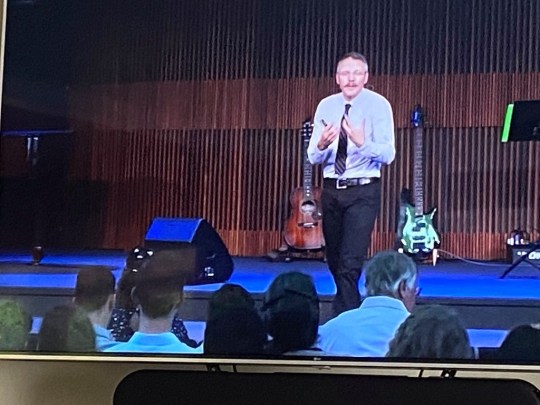

“ALL ROADS LEAD TO ROMANS”
A Sermon Series on the Book of Romans by David Asscherick
By Jesse Reyes
On a sweltering day on the 4th of July, I felt eager to listen to a good sermon, one that would evoke fireworks in my soul on Independence Day in the United States. I decided to listen to Pastor David Asscherick’s sermon series on YouTube titled “All Roads Lead to Romans”, a series on the book of Romans. Pastor Asscherick, a very dynamic speaker, who moves about on the stage during his sermon, was pastor of Kingscliff Church in Australia at the time he dwelt on the series.
I only listened to Part 1 of the series titled “God’s Good News”, where Asscherick lays the groundwork for the whole series. He based this particular sermon on Romans 1:1-15.
Here are my notes on this sermon:
Sigve Tonstad, a Norwegian in origin and now professor of religion and medicine at Loma Linda University, in his book “Letter to the Romans” states that “Romans deserves to be read with reverence if for no other reason than it is one of the most influential pieces of literature of all time. This claim is defensible in absolute terms, and the influence of Romans relative to its size lies beyond computation.”
John Wesley, an English cleric, theologian and evangelist who was a leader of a revival movement within the Church of England known as Methodism, tracing his conversion to Martin Luther’s commentary on the book of Romans said “I felt my heart was strangely warmed. I felt I did trust in Christ, Christ alone, for salvation, and an assurance that He had taken away my sins.”
Martin Luther, a German professor of theology, composer, priest, Augustinian monk, and a seminal figure in the Protestant Reformation wrote “This letter is truly the most important piece in the New Testament. It is the purest gospel. It is well worth a Christian’s while not only to memorize it but also to occupy himself with it daily as though it were the daily bread of the soul. It is impossible to read or meditate on this letter too much or too well.”
Rome was the imperial capital of Roman Empire at the time Romans was written.
Romans was written around AD 50, none more important book (letter) of Paul. It is the longest letter (16 chapters) impeccably argued because these are Paul’s well-researched sermons, unlike his other letters which addressed specific problems in the other churches.
Reasons why Romans was written (based on the written text and historical perspectives)
1. A kind of systematic theology
2. Support/awareness of his mission to Spain.
3. Wrapping up his work in East Mediterranean
4. Mediate between the “strong and weak”
5. Address the issue regarding Jew-Gentile
6. Address troublesome “counter-missionaries”
In AD 40 Roman Emperor Claudius expels Jews from Rome because of rioting and disturbances. When Claudius died, AD 54 Nero came to power and asked the Jews to return to Rome.
The book of Romans made sense due to the historical situation.
Romans 1:1 Paul, a slave of Jesus Christ. This amounted to social degradation because the Romans and some Jews considered Jesus, a crucified Messiah, a failure.
Shame is the one thing Roman society wanted to avoid.
Conversely, honor ranked highest in Roman values.
In his book “Romans: The new interpreter’s Bible”, N.T. Wright writes: “Paul’s contemporary Jews neither expected nor wanted a crucified Messiah . Paul’s contemporary Gentiles neither expected nor wanted to worship and serve the emperor.
In his book “Church history in Plain Language”, Bruce Shelley states: “Christianity is the only major religion that has as its central event the humiliation of its God.””
“Paul: A biography” N.T. Wright“ “From the time of Augustus onward, the Caesars had let it be known that events of their rule including their accession, their birthday, and so on were matters of “good news,” euangelion in Greek, since with Caesar as Kyrios (Lord) and Soter (“Savior”), a new golden age had arrived in the world.”
In “Romans: The New Interpreter’s Bible, N.T. Wright writes: “Remembering again that this is not after all, systematic theology but a letter addressed to a particular situation. Paul seems to explain to the Roman church what God has been up to (all along) and where they belong on the map of His purposes.
In “The Sonship of Christ”, Ty Gibson avers: “When we read the Bible as an unfolding narrative—as the big story it actually is with key characteristics played out an overarching, intentional plot line, the meaning of the Sonship of Christ becomes unmistakably evident. The God who made humanity intends to save humanity from the inside from within our very own genetic realm, from the strategic position of a God, of God who will be born within the Adamic and the Davidic lineage.
The Resurrected Messiah shows the power of the real Messiah.
“THE JUST SHALL LIVE BY FAITH”: Romans 1:15, 16. David Asscherick’s next sermon will be Part 2, “I Am Not Ashamed” and will be a treatise on just these two verses. I can’t wait to listen to it!
Written on July 5, 2020 in Chicago, IL. Other writings and poems of Jesse Reyes can be found in his blog: anadventurecalledlife.com. Posted in FB in 2020 and reposted in 2023.
0 notes
Text

Pick a Card: Keywords To Your Future Marriage
Choose a Metallica album picture in order to find out some small bits of random information I get about your future marriage.
Feel free to suggest PAC ideas in the inbox
Please like and reblog 〽️
©onenormalperson4012
masterlist
Pile 1
Queen of Cups, The Hierophant, Strength

Zoo, cups of tea drank in the park, church, religion, tradition, folklore, you watching them sleeping, blunt energy, victory, infinity, nephews(?), water slides, shower, bath, leaf, Monster drinks, blue t-shirt, a girl’s laugh, waist lift, sun, dancing, a lot of pop music, Spanish, 70s music, “you’re the one that I want” by Olivia Newton-John and John Trevolta, blue eyes, “Christian Woman” by Type O Negative, Ed Sheeran, Guitar, beach, lake, cold rain, maternal energy.
You will most likely have a beautiful family.
—————————————————
Pile 2
8 of Pentacles, 7 of Swords, Justice

Work, coworker, pranks, law, lawyer, sword fight, fencing, mask, doctor, colosseum, Roman Empire, history, Latin, theatre, Greek, Middle Eastern food, Middle Ages, wood, fire, Libra, air, deep stares into each other’s eyes, curly hair, short people, father looking at sports game, tiptoeing, stealing each other’s food for no reason, smiling under each other’s breaths, a lot of history fr, Vatican, “Ayy Ladies” by Travis Porter, “Bubblegum Bitch” by Marina and the Diamonds, clubbing together, forever young
What a nice pile, you also seem young.
—————————————————
Pile 3
Page of Wands, Knight of Cups, 8 of Pentacles
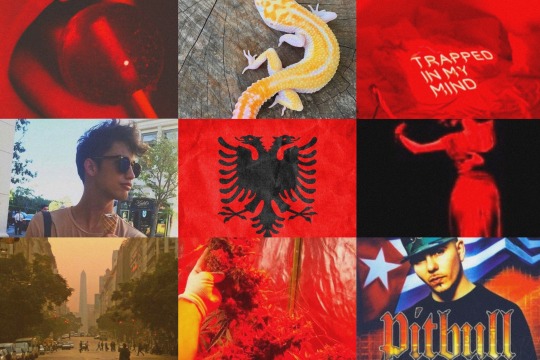
Traveling, dancing, drinking wine late in the night, Tango lol, Argentina, gecko, sand, animals, kids, red, orange, yellow, opposites, magnet, poles, matching colours, big height difference, North, Eagle, Albania, Alexander, Macedonia, peeking at each other, chill smile, red face, weed(?), “hahaha” with a male calm voice, tired, sex, sports, “Culo” by Pitbull lol, “Informer” by Snow, 4 years age gap, funny accent, sunglasses, meetings, running late, running, “oh fuck”, “I really really really really really really like you”
Are you guys that wild? If not, chose another pile.
—————————————————
Pile 4
Ace of Wands, 4 of Wands, 10 of Wands

“Fire” by BTS, alcohol, tequila, crying because of stress, disappointment, getting back together after 2-3 months of arguing, Maldives, microorganisms (?), science, “fuck you/off”, “never mind, forgive me please”, toxic, married too young, too much childishness, lion cereals, moving around, very guarded partners, early pregnancy, autumn, alone, teeth clenching, Aries, anger, divorce, “move”, “Heart Attack” by Demi Lovato, running, jogging, sports, instant connection, remarrying the same person, arguments.
Don’t marry young, I beg you. Especially if you know you’re childish or if you have Saturn in 7th house or in retrograde.
—————————————————
Pile 5
Ace of Pentacles, 2 of Wands, 9 of Swords

Money, wealthy life, happy, traveling together, singing together, “Grande Amore” by Il Volo, nightmares, paranoia, washing the dishes together, cleaning, cooking, piano, opera, offering help, one working from home, one is more confident than the other one, traditional, earth, Taurus, King of Pentacles, loyalty, true love, Ludovico Einaudi, Italy, brown vibe, earth, family, “I’m so happy”, “Safe and Sound” by Capital Cities, “Little Talks”(live) by Of Monsters and Men
Do you like classical music? This marriage has a very classy vibe to it.
—————————————————
Pile 6
10 of Pentacles, The Magician, 2 of Swords

A very beautiful family, a lot of manifesting, steady partners, old souls, a lot of support from both families, stars, cities, one or two children, living with parents, 90s music, France, Germany, Greenland, Singapore, garden, skiing, buying things for each other, a black dog(possibly a shepherd) and an orange dog, visiting relatives, kids, a man with a deep-raspy voice, country music, “Pricaj mi o Ljubavi” by Davoli, warm nights, red dress, falling asleep in each other’s arms, a brunette child, countryside.
This pile seems to have a very beautiful marriage. You seem to be made for each other.
—————————————————
Pile 7
Page of Cups, 4 of Cups, 6 of Cups

Love messages, doves, fish, fishing, gift giving, romance, a very romantic relationship, soulmates, some sort of unfairness between the partners, one wants to give it all while the other one is not the type to want to accept that all, swimming together, flowers, chocolate, blue, “I’m so happy I met you”, “We are soulmates for sure”, “Denis”(?), calm, chillness, biking, love letters, Cupid, “Colors” by Halsey.
The most romantic pile until now. You have the potential to stay married ‘till death separates you.
—————————————————
Not everyone gets a happy marriage, some people make mistakes and they lose their senses when they’re in love. I’m not willing to bring some of you down with those keywords. Remember that we are in charge of our own lives and we need to be careful who we chose to marry.
I hope it resonated and I’ll be continuing to do pick a card readings and I’ll see you next time. Bye bye
#astrology#romania#pac#tarot#onenormalperson4012#pick a card#pick a picture#tarot cards#tarot career#tarot advice#tarot free reading#tarotcommunity#tarot community#tarot pick a picture#tarot general reading#tarot reading#tarot love reading#soundcloud#spotify#future spouse reading#future spouse
720 notes
·
View notes
Text
17 places to see in Thessaloniki, Greece for starters
Thessaloniki is a city loved like few others. It is the second largest city in Greece and it is often referred to as the Capital of the North, Cultural Capital or Co-Capital to Athens, out of the love Greeks have for it. It offers a mix of ancient and medieval history, a diverse past, romanticism, vibrant nightlife, relaxed lifestyle and delicious cuisine that few can resist. There are countless things to see and do in Thessaloniki but these are the first 17 you have to tick off your list.
1. The White Tower
The landmark of Thessaloniki was built in 1535 by the Ottomans and was used as a prison that was originally called Tower of Blood. Allegedly, it got its current name after a Jewish prisoner was freed and agreed to paint the tower white. The tower hosts a gallery and offers tremendous views to the city and the Thermaic Gulf from its top.
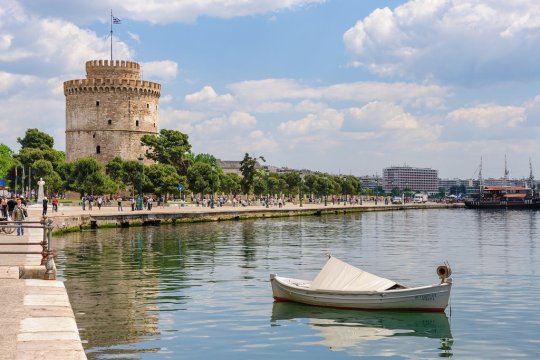
2. Aristotle Square
This is the most popular square in Thessaloniki, with beautiful and characteristic architecture like in Olympion movie theatre and Electra Palace as well as plenty of pretty cafes, bars and retail shops.

3. The harbour
The port of the city has the flair of everything old that has to adjust to the passage of time. Large industrial structures, strong artistic presence with the Museum of Cinematography and the Museum of Photography and the lively energy of the students who love to relax in this spot all together compose a special scene.
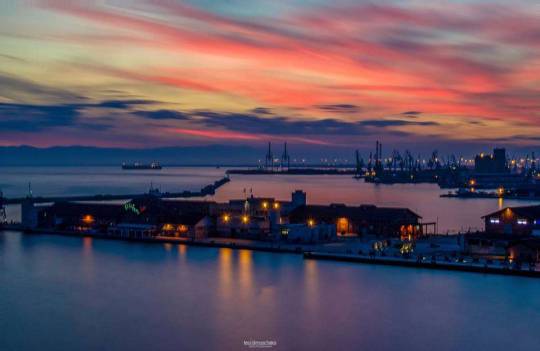
4. Alexander the Great statue
How could Alexander be far from his half-sister, Thessaloniki? Alexander’s statue in Thessaloniki is the largest in Greece and was sculpted in 1974 by Eu. Moustakas.
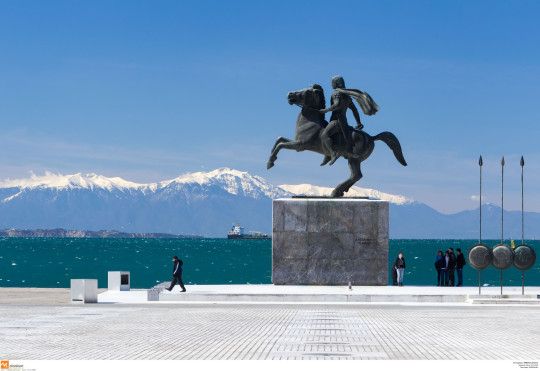
5. The Umbrellas
One of the most insta-popular spots of the city, the Umbrellas is a modern art composition by artist Giorgos Zoggolopoulos in 1995.
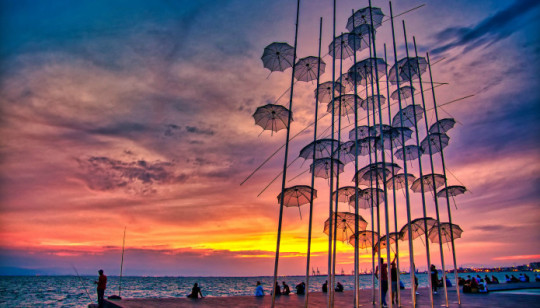
6. The New Waterfront
The New Waterfront is a wide and long walking and cycling park starting from Macedonia Palace Hotel and reaching the Concert Hall. It is popular with everybody, young and old, couples, athletes, cyclists, children and was recently created by architects Prodromos Nikephorides and Bernard Cuomo.
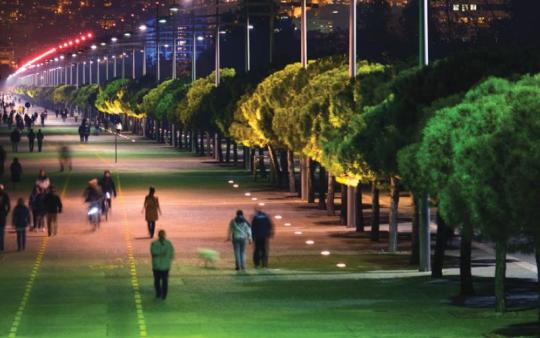
7. Nea Krini
Nea Krini, in the eastern suburbs of Thessaloniki, is a great place to unwind and try seafood and fish in the local restaurants. A stroll in the Aretsus Marina is a must too.
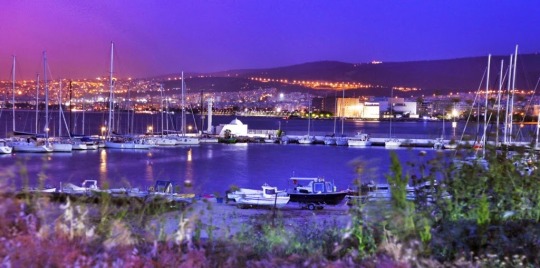
8. Saint Demetrius Church
This is an emblematic Palaeochristian church, with a very long history, where the relics of Saint Demetrius are kept. Demetrius is the patron saint of the city, because his nameday celebration is in 26 October and incidentally that was the day the city was liberated from the Ottoman Empire. Besides the saint’s remains, the church has crypts and catacombs beneath and is a UNESCO monument.
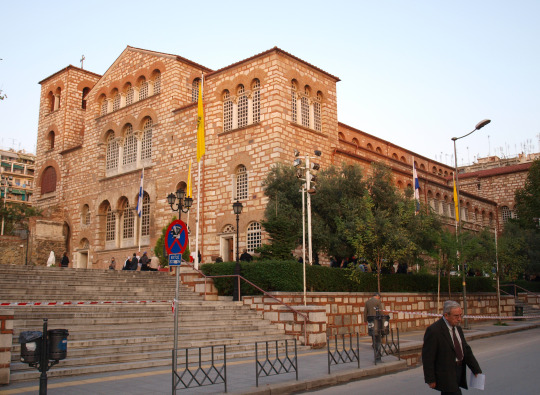
9. Saint Sophia Church
Another UNESCO monument, Saint Sophia church was built in the 8th century AD and is a prime example of Byzantine architecture.
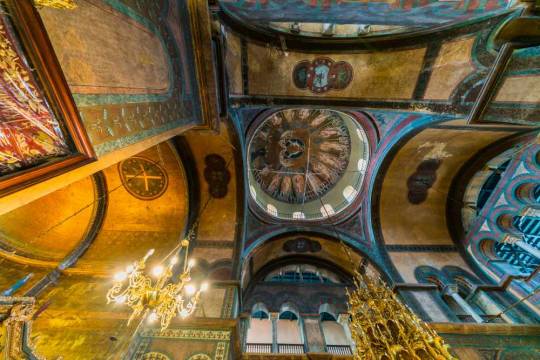
10. OTE Tower
Built in 1970, this 76 meter tall tower was originally OTE’s pavilion in the Thessaloniki’s International Fair. On its top there is a rotating roof cafe from which you can enjoy views to any angle of the city.
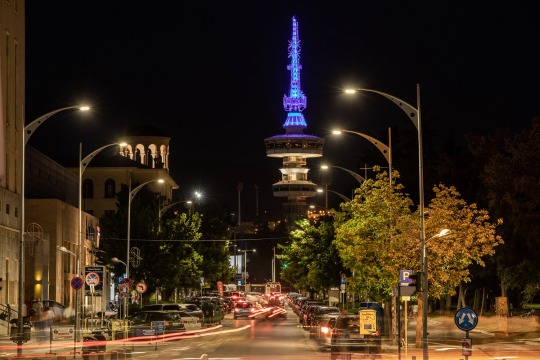
11. Turkish Baths
Thessaloniki's Turkish Baths might be the best preserved in Greece. They were built in 1444, often with materials taken from Christian churches and functioned as baths until 1968.
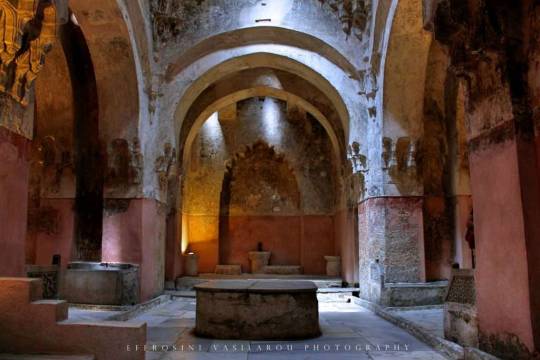
12. Arch of Galerius
Also known as “Kamara”, this is the most common meeting point in the city. Kamara is the surviving arch of the palace the Roman Emperor Galerius built in order to celebrate his victories against the Persians.
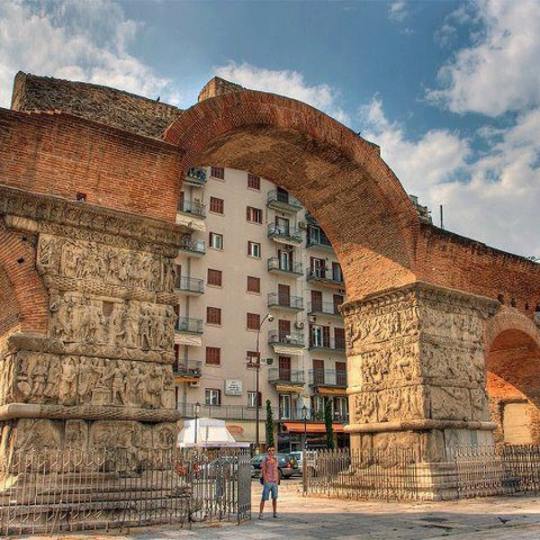
13. Upper Town
This is the elevated old town of Thessaloniki, surrounded by the fortresses. Upper Town is great for a visit in the evening and at night and it offers spectacular views to the city and sea plus many options in seafood and traditional coffee shops.
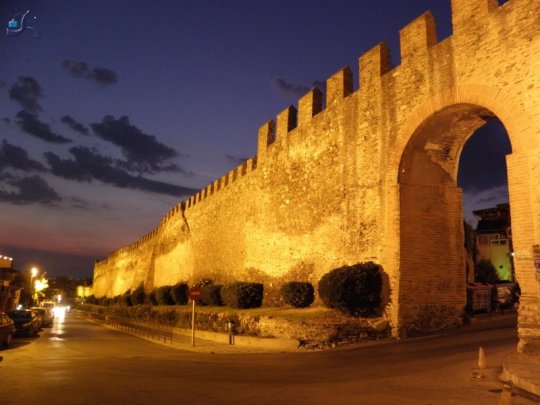
14. Rotunda
Rotunda was built in the 4th century AD by emperor Galerius and it was meant to be a Pantheon or a mausoleum. Galerius died early though and the building was turned into a christian church while in the 16th century the Ottomans turned it into a mosque. Rotunda suffered a lot from earthquakes but large parts of its original mosaics are rescued.
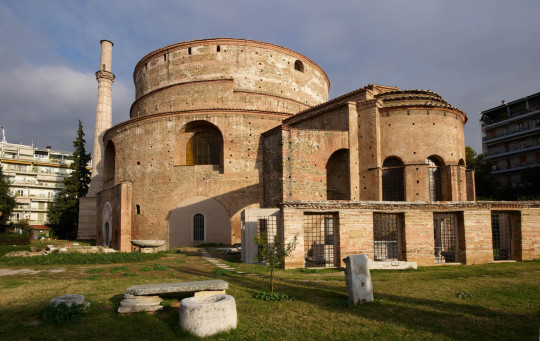
15. Ladadika
A district where oil was sold, and where prior to 1990 the sex workers would be found, earning such a reputation that songs were written about this, has nowadays become one of the hotspots of the city with vibrant restaurants, cafes, bars and hotels. Hence its vibrant lighthearted yet vaguely underground aesthetic.
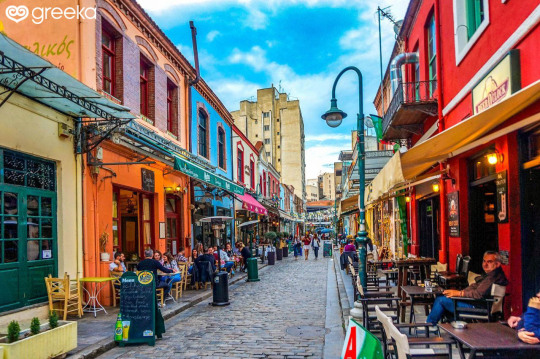
16. The Archaeological Museum of Thessaloniki
It is the largest archaeological museum in Northern Greece and one of the biggest in the country. Its exhibits are of huge significance and come mostly from Thessaloniki and the greater region of Macedonia. It covers prehistoric times until late antiquity.
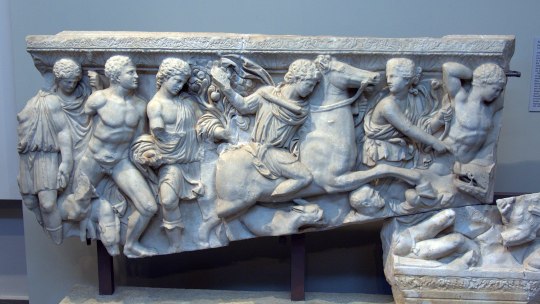
17. The Museum of Byzantine Culture of Thessaloniki
It is one of the most important Byzantine museums in Greece and it is also acclaimed for its design, a notable example of Modern Greek architecture. The museum covers all aspects of everyday life in the Byzantine Empire, the ecclesiastical art, the Byzantine Emperors and the life in the imperial palace as well as the Byzantine legacy in Modern Greece.
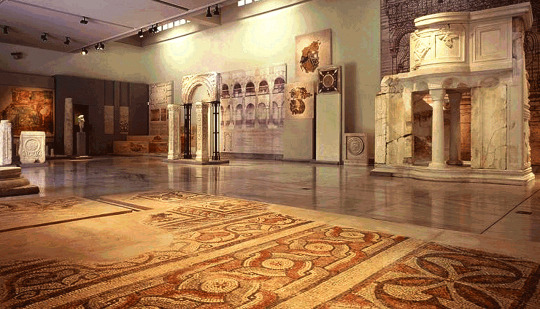
Original source in Greek (made some modifications with the recommendations)
#greece#europe#city#travel guide#tourist guide#travel#wanderlust#thessaloniki#macedonia#mainland#white tower#ote tower#ladadika#saint Sophia church#saint Demetrius church#rotunda#arch of galerius#Turkish baths#upper town of thessaloniki#Aristotle square#archaeological museum of thessaloniki#museum of byzantine culture
188 notes
·
View notes
Photo












Temple of Ba’al Shamin
Palmyra (Tadmor), Syria
131 CE
The temple of Baalshamin was a prostyle (having free standing columns on the façade only), tetrastyle (four columns across the façade) temple of the Corinthian order with a deep porch (visible in the photo below). As with other Palmyrene architecture, the sanctuary of Baalshamin demonstrated hybridity of design—incorporating both Near Eastern and Graeco-Roman elements. The temple was set within a colonnaded precinct. The temple building dated to c. 130 CE with its altar was built in 115 CE and represents an addition to a sanctuary that already existed by 17 CE. The temple itself is conventional in its external design, meaning it conforms to what one would expect from a Classical Graeco-Roman structure. The four freestanding columns across the façade are complemented by engaged pilasters at the sides and back.
The temple’s cult is dedicated to Baalshamin or Ba'al Šamem, a northwest Semitic divinity. The name Baalshamin is applied to various divinities at different periods in time, but most often to Hadad, also known simply as Ba’al. Along with Bel, Baalshamin was one of the two main divinities of pre-Islamic Palmyra in Syria and was a sky god.
The colonnaded precinct experienced several phases of development during the first century CE. (prior to the addition of the current temple). By the time of the temple’s construction, the colonnade had become a so-called Rhodian peristyle—meaning one flank was taller than the other three. The complex continued to develop across the course of the second century.The temple itself adopts a Near Eastern motif of including a window in each of the cella’s flanks, a trait that is not Graeco-Roman but that finds comparison in contemporary temples in Lebanon. These windows reflect the belief that the divinity dwelled in the temple.
The temple was originally a part of an extensive precinct of three courtyards and represented a fusion of ancient Syrian and Roman architectural styles. The temple's proportions and the capitals of its columns were Roman in inspiration, while the elements above the architrave and the side windows followed the Syrian tradition. The highly stylized acanthus patterns of the Corinthian orders also indicated an Egyptian influence. The temple had a six-column pronaos with traces of corbels and an interior which was modelled on the classical cella. The side walls were decorated with pilasters.
The temple would have been closed during the persecution of pagans in the late Roman Empire in a campaign against the temples of the East made by Maternus Cynegius, Praetorian Prefect of Oriens, between 25 May 385 to 19 March 388. With the spreading of Christianity in the region in the 5th century CE, the temple was converted to a church.


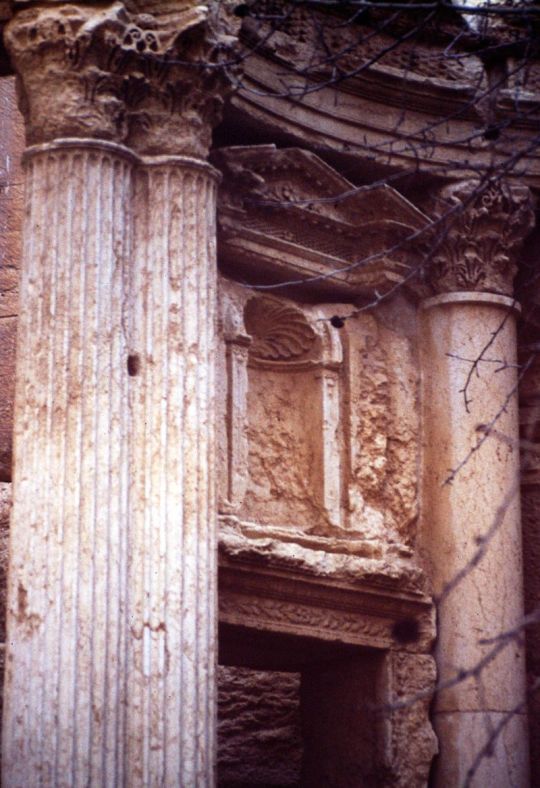


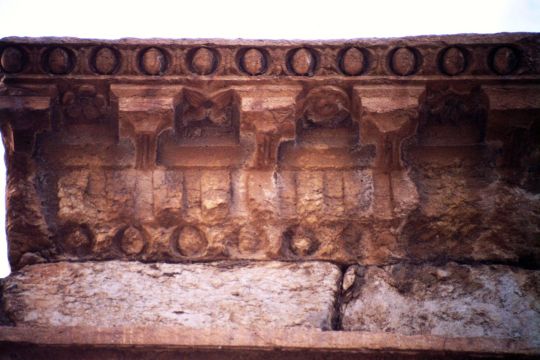


Sources: 1, 2, 3, 4, 5

On 23 August 2015, Islamic Terrorist organization ISIS militants detonated a large quantity of explosives inside the Temple of Baalshamin, completely destroying the building.
#history#art#Architecture#travel#roman#roman art#roman architecture#baal#bel#baalshamin#sky#prostyle#tetrastyle#conch#merlon#mythology#hadad#temple#window#palmyra#tadmor#tadmur#syria#middle east#eagle
666 notes
·
View notes
Text
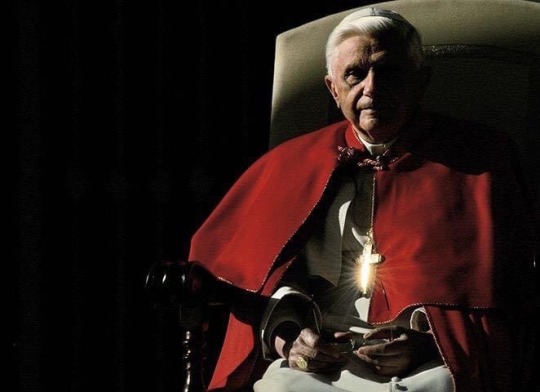
Can the Ladder, a work written by a hermit monk who lived 1,400 years ago, say something to us today? Can the existential journey of a man who lived his entire life on Mount Sinai in such a distant time be relevant to us?
Dear Brothers and Sisters,
After 20 Catecheses dedicated to the Apostle Paul, today I would like to return to presenting the great writers of the Church of the East and of the West in the Middle Ages. And I am proposing the figure of John known as Climacus, a Latin transliteration of the Greek term klimakos, which means of the ladder (klimax). This is the title of his most important work in which he describes the ladder of human life ascending towards God. He was born in about 575 a.d. He lived, therefore, during the years in which Byzantium, the capital of the Roman Empire of the East, experienced the greatest crisis in its history. The geographical situation of the Empire suddenly changed and the torrent of barbarian invasions swept away all its structures. Only the structure of the Church withstood them, continuing in these difficult times to carry out her missionary, human, social and cultural action, especially through the network of monasteries in which great religious figures such as, precisely, John Climacus were active.
John lived and told of his spiritual experiences in the Mountains of Sinai, where Moses encountered God and Elijah heard his voice. Information on him has been preserved in a brief Life (PG 88, 596-608), written by a monk, Daniel of Raithu. At the age of 16, John, who had become a monk on Mount Sinai, made himself a disciple of Abba Martyr, an "elder", that is, a "wise man". At about 20 years of age, he chose to live as a hermit in a grotto at the foot of the mountain in the locality of Tola, eight kilometres from the present-day St Catherine's Monastery. Solitude, however, did not prevent him from meeting people eager for spiritual direction, or from paying visits to several monasteries near Alexandria. In fact, far from being an escape from the world and human reality, his eremitical retreat led to ardent love for others (Life, 5) and for God (ibid., 7). After 40 years of life as a hermit, lived in love for God and for neighbour years in which he wept, prayed and fought with demons he was appointed hegumen of the large monastery on Mount Sinai and thus returned to cenobitic life in a monastery. However, several years before his death, nostalgic for the eremitical life, he handed over the government of the community to his brother, a monk in the same monastery.
John died after the year 650. He lived his life between two mountains, Sinai and Tabor and one can truly say that he radiated the light which Moses saw on Sinai and which was contemplated by the three Apostles on Mount Tabor!
He became famous, as I have already said, through his work, entitled The Climax, in the West known as the Ladder of Divine Ascent (PG 88, 632-1164). Composed at the insistent request of the hegumen of the neighbouring Monastery of Raithu in Sinai, the Ladder is a complete treatise of spiritual life in which John describes the monk's journey from renunciation of the world to the perfection of love. This journey according to his book covers 30 steps, each one of which is linked to the next. The journey may be summarized in three consecutive stages: the first is expressed in renunciation of the world in order to return to a state of evangelical childhood. Thus, the essential is not the renunciation but rather the connection with what Jesus said, that is, the return to true childhood in the spiritual sense, becoming like children. John comments: "A good foundation of three layers and three pillars is: innocence, fasting and temperance. Let all babes in Christ (cf. 1 Cor 3: 1) begin with these virtues, taking as their model the natural babes" (1, 20; 636). Voluntary detachment from beloved people and places permits the soul to enter into deeper communion with God. This renunciation leads to obedience which is the way to humility through humiliations which will never be absent on the part of the brethren. John comments: "Blessed is he who has mortified his will to the very end and has entrusted the care of himself to his teacher in the Lord: indeed he will be placed on the right hand of the Crucified One!" (4, 37; 704).
The second stage of the journey consists in spiritual combat against the passions. Every step of the ladder is linked to a principal passion that is defined and diagnosed, with an indication of the treatment and a proposal of the corresponding virtue. All together, these steps of the ladder undoubtedly constitute the most important treatise of spiritual strategy that we possess. The struggle against the passions, however, is steeped in the positive it does not remain as something negative thanks to the image of the "fire" of the Holy Spirit: that "all those who enter upon the good fight (cf. 1 Tm 6: 12), which is hard and narrow,... may realize that they must leap into the fire, if they really expect the celestial fire to dwell in them" (1,18; 636). The fire of the Holy Spirit is the fire of love and truth. The power of the Holy Spirit alone guarantees victory. However, according to John Climacus it is important to be aware that the passions are not evil in themselves; they become so through human freedom's wrong use of them. If they are purified, the passions reveal to man the path towards God with energy unified by ascesis and grace and, "if they have received from the Creator an order and a beginning..., the limit of virtue is boundless" (26/2, 37; 1068).
The last stage of the journey is Christian perfection that is developed in the last seven steps of the Ladder. These are the highest stages of spiritual life, which can be experienced by the "Hesychasts": the solitaries, those who have attained quiet and inner peace; but these stages are also accessible to the more fervent cenobites. Of the first three simplicity, humility and discernment John, in line with the Desert Fathers, considered the ability to discern, the most important. Every type of behaviour must be subject to discernment; everything, in fact, depends on one's deepest motivations, which need to be closely examined. Here one enters into the soul of the person and it is a question of reawakening in the hermit, in the Christian, spiritual sensitivity and a "feeling heart", which are gifts from God: "After God, we ought to follow our conscience as a rule and guide in everything," (26/1,5; 1013). In this way one reaches tranquillity of soul, hesychia, by means of which the soul may gaze upon the abyss of the divine mysteries.
The state of quiet, of inner peace, prepares the Hesychast for prayer which in John is twofold: "corporeal prayer" and "prayer of the heart". The former is proper to those who need the help of bodily movement: stretching out the hands, uttering groans, beating the breast, etc. (15, 26; 900). The latter is spontaneous, because it is an effect of the reawakening of spiritual sensitivity, a gift of God to those who devote themselves to corporeal prayer. In John this takes the name "Jesus prayer" (Iesou euche), and is constituted in the invocation of solely Jesus' name, an invocation that is continuous like breathing: "May your remembrance of Jesus become one with your breathing, and you will then know the usefulness of hesychia", inner peace (27/2, 26; 1112). At the end the prayer becomes very simple: the word "Jesus" simply becomes one with the breath.
The last step of the ladder (30), suffused with "the sober inebriation of the spirit", is dedicated to the supreme "trinity of virtues": faith, hope and above all charity. John also speaks of charity as eros (human love), a symbol of the matrimonial union of the soul with God, and once again chooses the image of fire to express the fervour, light and purification of love for God. The power of human love can be reoriented to God, just as a cultivated olive may be grafted on to a wild olive tree (cf. Rm 11: 24) (cf. 15, 66; 893). John is convinced that an intense experience of this eros will help the soul to advance far more than the harsh struggle against the passions, because of its great power. Thus, in our journey, the positive aspect prevails. Yet charity is also seen in close relation to hope: "Hope is the power that drives love. Thanks to hope, we can look forward to the reward of charity.... Hope is the doorway of love.... The absence of hope destroys charity: our efforts are bound to it, our labours are sustained by it, and through it we are enveloped by the mercy of God" (30, 16; 1157). The conclusion of the Ladder contains the synthesis of the work in words that the author has God himself utter: "May this ladder teach you the spiritual disposition of the virtues. I am at the summit of the ladder, and as my great initiate (St Paul) said: "So faith, hope, love abide, these three; but the greatest of these is love' (1 Cor 13: 13)!" (30, 18; 1160).
At this point, a last question must be asked: can the Ladder, a work written by a hermit monk who lived 1,400 years ago, say something to us today? Can the existential journey of a man who lived his entire life on Mount Sinai in such a distant time be relevant to us? At first glance it would seem that the answer must be "no", because John Climacus is too remote from us. But if we look a little closer, we see that the monastic life is only a great symbol of baptismal life, of Christian life. It shows, so to speak, in capital letters what we write day after day in small letters. It is a prophetic symbol that reveals what the life of the baptized person is, in communion with Christ, with his death and Resurrection. The fact that the top of the "ladder", the final steps, are at the same time the fundamental, initial and most simple virtues is particularly important to me: faith, hope and charity. These are not virtues accessible only to moral heroes; rather they are gifts of God to all the baptized: in them our life develops too. The beginning is also the end, the starting point is also the point of arrival: the whole journey towards an ever more radical realization of faith, hope and charity. The whole ascent is present in these virtues. Faith is fundamental, because this virtue implies that I renounce my arrogance, my thought, and the claim to judge by myself without entrusting myself to others. This journey towards humility, towards spiritual childhood is essential. It is necessary to overcome the attitude of arrogance that makes one say: I know better, in this my time of the 21st century, than what people could have known then. Instead, it is necessary to entrust oneself to Sacred Scripture alone, to the word of the Lord, to look out on the horizon of faith with humility, in order to enter into the enormous immensity of the universal world, of the world of God. In this way our soul grows, the sensitivity of the heart grows toward God. Rightly, John Climacus says that hope alone renders us capable of living charity; hope in which we transcend the things of every day, we do not expect success in our earthly days but we look forward to the revelation of God himself at last. It is only in this extension of our soul, in this self-transcendence, that our life becomes great and that we are able to bear the effort and disappointments of every day, that we can be kind to others without expecting any reward. Only if there is God, this great hope to which I aspire, can I take the small steps of my life and thus learn charity. The mystery of prayer, of the personal knowledge of Jesus, is concealed in charity: simple prayer that strives only to move the divine Teacher's heart. So it is that one's own heart opens, one learns from him his own kindness, his love. Let us therefore use this "ascent" of faith, hope and charity. In this way we will arrive at true life.
Vatican, Feb. 11, 2009
7 notes
·
View notes
Text
Advice for Little Me
This is advice that I have for my twelve-year-old self. If I’d known all this at twelve my life would be a whole lot better.
1) Capitalists are horrible, manipulative, lying, selfish, apathetic, overwhelmingly dangerous, incredibly bad for society, wrong, and deeply disturbed.
2) Anyone who ever says or insinuates that they earned the wealth they have are the worst types of people.
3) Anyone who goes around measuring the value of a human being by how fancy their job is incredibly shallow, materialistic, lacking in understanding, and not worth your time.
4) No. No people did not "earn" anything through hard work. They got it through privilege, privilege, privilege, and privilege. The fact that they could afford a decent quality highschool education is already a huge privilege. And no, being poor when they were in college absolutely does not count as not having privilege. They got to go to college. That’s a privilege so many don’t get.
5) You know who's actually working hard? The people in the sweatshops, the mines, the agricultural plantations, the warehouses, etc. The people getting paid poverty wages as they work themselves to death. Have some fucking respect for them you’re not above them just because you were born in a rich family.
6) All humans have equal value.
7) And the value of a human being is inherent.
8) If you have a house and fancy furniture and a flatscreen TV and a car and a closet full of clothes and enough money to go to restaurants and golfing and shit and then you turn around and say you're oppressed I fucking hate you so goddamn much.
9) The voices of the poor people are fucking ALWAYS silenced in this world, all over the world.
10) There's men in suits somewhere defending capitalism and our centrist dads are defending them while most of the world are wage slaves.
11) The poor are always ignored, pushed to the side, and silenced.
12) Hi. Hello person reading this. Check out the Red Deal. It's fucking awesome. Please read it. It will save your soul and change your life.
13) Also my Wattpad account is here please check it out https://www.wattpad.com/user/Balladoad it won't save your soul and change your life but I write communist stories.
14) Your value is inherent. Child. Darling. Your value is inherent. You are alive. That is enough. You don't need a fancy job or a big income or a fancy degree or something. You're a human being trying to do the best you personally can with the resources and knowledge you have and in the situation you're in. Your value is inherent. Baby.
15) Check out the Red Deal.
16) Nobody is liberated. None of us are liberated. Especially under capitalism none of us are liberated. We are all equal. We are all capable of being free. Of having an equal amount of power. Of making decisions equally and democratically where everyone has a seat at the round table. Seperation is a myth. Wow that sounds like a fucking hippie thing to say but I mean it in the most practical, tangible way. We are all equal and we should be treated equally and under capitalism we are not. Not even close. We can all be together, all be comrades, all help and support each other, all protect and provide for each other, all listen to and understand each other, and all create a world where finally, finally people are free.
17) True freedom does not and should not feel forced. Corporate capitalists tell us that freedom is the ability to be successful in the capitalist framework. That is not what true freedom is. True freedom comes from within. It does not feel forced. It feels good and right and beautiful and true. It's not forced upon you it's something that sparks to life inside your own soul.
18) Sucess as a human being is about the kindness and compassion you show other people. Which is actually rather inversely proportional to how much money you make from what I've seen. At every step of your life seek out people who need help and help them.
19) Children should all be treated with equal respect, reverance, affection, and love.
20) Your value is inherent. Human value is inherent. Valuing human life does mean valuing the continuation of human life but not just that. It means valuing the quality of human life too. It means valuing human happiness.
21) Take every opportunity you have to learn. Not learn trivial "knowledge" about string theory or CRISPR or valence orbitals. Real, important knowledge about how to be kind to other people. How to be respectful towards other people. How to uplift the downtrodden. How to be in solidarity with the oppressed. How to live in harmony with other people. How to tear down the walls that divide us. How to live in harmony with nature. How to have respect and reverence for nature. How to protect and defend the Land and Water. How to be brave to put the needs of others before your own. How to think for yourself and be your own person. How to live your life in accordance to the truth and intangible mystic forces behind everything that guide us all. Wow that sounded hippie.
22) People are exploited and oppressed. So many people are exploited and oppressed. They deserve better than this.
23) You shouldn’t go after power. Seeking power is the way to corruption. You should seek to destroy the unequal distribution of power itself so that all people can have equal power.
24) Absolutely power corrupts absolutely. Power corrupts whenever it’s not equally shared.
25) Money is power. It always has been, it always will be. It’s what determines if people are able to eat or not. It’s what makes us spend most of our time at our jobs working for our bosses and doing what they want us to do.
26) Learn history. Please.
27) Read books about the Holocaust. About slavery. About all the types of slavery that have happened in various societies not just the Transatlantic Slave Trade though definitely you should learn about that too. About the Irish Potato Famine, the Armenian Genocide. About colonialism. About settler-colonialism. About feudalism. About monarchy. About the Industrial Revolution. About segregation. About the genocide of Indigenous peoples. About workhouses. About the Witch Trials. About the French Revolution. About the Spanish resistance against fascism. About residential schools. About the 60s Scoop. About the Stolen Generations. About resistance against the Roman Empire. About so much more. Just read them. Make sure they’re not written through the lenses of oppressors and/or rich people though.
28) Recognize that while history affects the present day history IS NOT the present day and present struggles are unique and different though not altogether separated from history. The present day is the present day. It’s struggles are unique and the way that the struggle for universal equality and liberation manifests in the present day is unique.
30) Don’t trust Christian priests.
31) Actually be cautious of any rich, privileged person trying to teach you religion.
32) Just because someone’s older doesn’t mean that they’re right or they know more than you. Knowledge of the truth and wisdom comes from kindness, compassion, humility, and suffering. It does not come from age. A rich man born to a rich family who thinks he’s better than poor people and does not have humility and respect towards them is not someone who knows things, no matter how old he is.
33) Men are generally less trustable than women because they’ve been taught to believe they’re always right and as such do not question themselves and think deeply and critically about their opinions as much as women do.
34) This does not apply to men who are poor or mentally ill since society never teaches them that.
35) Despite this being an unpopular opinion, pain and struggle are actually really good teachers. If you’re suffering, you deserve better. You deserve to not be suffering. But still, use it as an opportunity to learn.
37) Gender roles are the biggest scam ever created.
38) But the even bigger scam is capitalism.
39) You do not need material wealth. It is inherently addictive and bad for yourself, everyone else, and the Land and Water.
40) It’s just stuff. It doesn’t matter.
41) If you’re in a situation where people are treating you like you’re better than other people just get the fuck out of that situation as fast as you can. And never fucking look back no matter what ANYONE says.
42) Have respect and reverence for nature. Learn from it as much as you can. But from like, nature directly. Not from people talking about nature. Unless they’re Indigenous. And pristine, untouched nature is better than nature that’s been tampered with.
43) The world runs on bonds of love more than bonds between atoms.
44) Work hard not for money or to increase the power you have but rather to humbly and reverently improve the lives of the oppressed.
45) But recognize that you can’t do everything and do what you can and don’t beat yourself up over the things you can’t do.
#advice#eat the rich#capitalism#advice for living#advice for myself#I wish someone had told me this#rebellion
9 notes
·
View notes
Text
Saints&Reading: Mon., Mar., 8, 2021
Commemorated on February 23_by the new CAlendar
Saint Polycarp, Bishop of Smyrna (167)

Saint Polycarp, Bishop of Smyrna, was born about the year 80 and lived in Asia Minor in the city of Smyrna. He was left an orphan at an early age, but through the direction of an Angel, he was raised by the pious widow Kallista. After the death of his adoptive mother, Polycarp gave away his possessions and began to lead a chaste life, caring for the sick and the infirm. He was very fond of and close to the holy bishop of Smyrna Bukolos (Comm. 6 February). He ordained Polycarp as deacon, entrusting to him to preach the Word of God in church. At this time the holy Apostle John the Theologian was still alive. Saint Polycarp was especially close to Saint John the Theologian, whom he accompanied on his apostolic wanderings. Saint Bukolos ordained Saint Polycarp presbyter, and shortly before his death expressed last wishes that he be made bishop upon the Smyrna cathedral. When the ordination of Saint Polycarp to bishop was accomplished, the Lord Jesus Christ appeared to him. Saint Polycarp guided his flock with apostolic zeal. He was also greatly loved among the clergy. With great warmth did Saint Ignatios the God-Bearer regard him. Setting out to Rome where execution awaited him (he was torn asunder by wild beasts), he wrote to Saint Polycarp: "Just as the winds and turbulence require the rudder – for coming ashore, so likewise are the present times necessary, in order to reach God".
The emperor Marcus Aurelius (161-180) came upon the Roman throne and started up a most fierce persecution against christians. The pagans demanded that the judge seek out Saint Polycarp – "the father of all the christians" and "the seducer of all Asia". During this while Saint Polycarp, at the persistent urging of his flock, stayed at a small village not far from Smyrna. When the soldiers came for him, he went out to them and led them in to eat, and at this time he began to pray, having prepared himself for the deed of martyrdom. His suffering and death are recorded in "An Epistle of the Christians of the Church of Smyrna to the other Churches" – one of the most ancient memorials of Christian literature. Having been brought to trial, Saint Polycarp firmly confessed his faith in Christ and was condemned to burning. The executioners wanted to tie him to a post, but he calmly told them that the bon-fire would not work, and they could merely tie him with ropes. The flames encircled the saint but did not touch him, coming all together over his head. Seeing that the fire did him no harm, the throng of pagans demanded that he be killed with a sword. When they inflicted the wound upon Saint Polycarp, there flowed from it so much blood, that it extinguished the flames. The body of the priestmartyr Polycarp was then committed to flame. The Christians of Smyrna reverently gathered up his venerable remains, honouring his memory as sacred. A story has been preserved about Saint Polycarp by his disciple, Saint Ireneius of Lyons, which Eusebios cites in his "Ecclesiastical History" (V, 20): "I was still very young when I saw thee in Asia Minor at Polycarp's, – writes Saint Ireneius to his friend Florinus, – ...but I would still be able to point out the place where Blessed Polycarp sat and conversed, – be able to depict his walk, his mannerisms in life, his outward appearance, his speaking to people, his companionable wandering with John, and how he himself related, together with other eye-witnesses of the Lord, – those things that he remembered from the words of others and in turn told what he heard from them about the Lord, His teachings and miracles ... Through the mercy of God to me, I then already listened attentively to Polycarp and wrote down his words not on tablets, but in the depths of my heart ... Wherefore, I am able to witness before God, that if this blessed and apostolic elder heard something similar to thy fallacy, he would immediately stop up his ears and express his indignation with his usual phrase: 'Good God! That Thou hast permitted me to be alive at such a time!' ". During his life the saint bishop wrote several Epistles to the flock and letters to various individuals. There has survived to the present his Epistle to the Philippians which, on the testimony of Blessed Jerome, was read in the churches of Asia Minor at Divine-services. It was written by the saint in response to the request of the Philippians to send them a letter of the Priest Martyr Ignatius, which had been preserved by Saint Polycarp.
The Monk Alexander, Founder of the "Unceasing Vigilance" Monastery (430)

The Monk Alexander, Founder of the "Unceasing Vigilance" Monastery, was born in Asia and received his education at Constantinople. He spent some time in military service but, sensing a calling to other service, he left the world and accepted monastic vows in one of the wilderness monasteries near Antioch under the guidance of hegumen Elias. Having advanced bit by bit through the degrees of monastic obedience, he received blessing from the hegumen to dwell in the wilderness. The monk pursued asceticism in the wilderness with but the Holy Gospel, which alone he took with him. Afterwards, the Lord summoned him to preach to pagans. He converted to the faith the local city-head Rabbul, who afterwards prospered in the service of the Church, being granted the dignity of bishop and for all of 30 years he occupied the bishop's cathedra (chair) at the city of Edessa. Finally, the monk Alexander settled not far from the Euphrates River. Monks gathered around him, attracted by the loftiness of his prayerful asceticism and spiritual experience. A monastery arose numbering 400 monks. Then the holy hegumen in his prayerful zeal decided to make at the monastery both by day and by night never-ceasing praise to the Lord. For three years the holy abba prayed, that God might reveal to him, whether it should be pleasing to Him to establish such a monastic rule. And by a Divine revelation it was brought about in the following manner: all the monks were divided by him into 24 watches of prayer. Changing shifts each hour, they sang in two choirs both day and night the holy psalms, with the exceptions when Divine-services were celebrated in church. Hence the name "Monastery of Unceasing Vigilance", since unceasing song was offered up by the ascetics to God. The monk Alexander guided the monastery on the Euphrates for twelve years. Thereafter, having left as its hegumen the experienced elder Trophymos, he set off with some chosen brethren through the cities bordering on Persia, to preach the Gospel and conversion to spiritual life. Having arrived at Constantinople, capital of the Byzantine empire, he also established there a monastery with his favoured ustav (rule) of "unceasing vigilance". The monastic abba died in extreme old age after fifty years of incessant monastic striving. His death occurred in the year 430. The commemoration of the Monk Alexander is also celebrated on 3 July.
All texts© 1996-2001 by translator Fr. S. Janos.


3 John 1:1-14
1The Elder, To the beloved Gaius, whom I love in truth: 2 Beloved, I pray that you may prosper in all things and be in health, just as your soul prospers. 3 For I rejoiced greatly when brethren came and testified of the truth that is in you, just as you walk in the truth. 4 I have no greater joy than to hear that my children walk in truth. 5 Beloved, you do faithfully whatever you do for the brethren and for strangers, 6 who have borne witness of your love before the church. If you send them forward on their journey in a manner worthy of God, you will do well, 7 because they went forth for His name's sake, taking nothing from the Gentiles. 8 We therefore ought to receive such, that we may become fellow workers for the truth. 9 I wrote to the church, but Diotrephes, who loves to have the preeminence among them, does not receive us. 10 Therefore, if I come, I will call to mind his deeds which he does, prating against us with malicious words. And not content with that, he himself does not receive the brethren, and forbids those who wish to, putting them out of the church. 11 Beloved, do not imitate what is evil, but what is good. He who does good is of God, but he who does evil has not seen God. 12 Demetrius has a good testimony from all, and from the truth itself. And we also bear witness, and you know that our testimony is true. 13 I had many things to write, but I do not wish to write to you with pen and ink; 14 but I hope to see you shortly, and we shall speak face to face. Peace to you. Our friends greet you. Greet the friends by name.
#orthodoxy#orthodoxchristian#ancientchristianity#originofchristianity#spirituality#holyscriptures#gospel#sacredtexts#wisdom
2 notes
·
View notes
Text
treasure at tampines appointment
Turkey now occupies a territory that once belonged to the glorious Byzantine Empire. It was dotted with castles, fortresses and churches, some of these still standing today. Such remnants speak of a time when great architecture was developed, along with decorative arts and painting. Mosaics were also a pinnacle of Byzantine art.
To explore more of this precious heritage, one must go beyond the touristic Istanbul with its world-famed Hagia Sophia cathedral, although this is without a doubt the finest example of what the Byzantines could do.
1. The Alanya Castle
A typical Byzantine fortress with numerous structures within its walls, the Alanya castle is a vast construction on rocky land, right on the sea shore. It presents itself in a good condition nowadays, thanks to careful reconstruction works. However, the influences are diverse: there are also Roman remnants, as well as medieval Ottoman constructions and newer Turkish architecture.
2. Monuments in Ankara
Turkey's capital city, Ankara, host a series of ancient Byzantine monuments. First and foremost, there is its treasure at tampines appointment old tower - the symbol of the city, built in the 9th century. Then, you have the church built on the remains of the Temple of Augustus and the Monastery of Eskigumus. Ihlara Valley in the region is host to numerous Byzantine paintings and frescoes.
3. Trabzon Heritage
There is much to see in Trabzon in Anatolia, where construction techniques were different. You can start with the smaller copy of Istanbul's Hagia Sophia, with its fully restored colorful murals. See the Fatih Camii, former Byzantine church. This used to be a place where emperors were crowned. The Kaymakli Monastery is equal in splendor, as well as the Sumela Monastery of the 4th century.
4. The Cappadocia Retreats
These are lodging of Christians in the first centuries of this religion, used as retreats for hermits, but also taking the shape of churches and chapels. Historians confirmed there was continuation in Byzantine times, visible today in the rock-cut churches with frescoes. Also, the area represents a true natural wonder, attracting and fascinating visitors all year round.
Although there are many other places to feature Byzantine architecture and relics, they are rather heard to reach. The mentioned locations, along with Instanbul, host the greatest concentration of such monuments, and are well preserved and easily accessible to visitors. Despite of the name changes, the Byzantine buildings are easy to spot due to their distinct architecture.
2 notes
·
View notes
Text
Judgment XX
Part 1
When I was sixteen, I came home from school one day and my mother gathered my little sister and I in the living room with an enormous sense of urgency. Her face was full of fear and sorrow as she presented us each with a backpack, and told us that everything we would need to hopefully survive could be found inside. A change of clothes, running shoes, thermal blanket, protein bars, tablets to disinfect drinking water, basic first aid supplies, iodine tablets to prevent the body from absorbing radiation, and a bundle of cash in small bills.
She informed us that the very next day, according to the prediction of an evangelical pastor, the rapture would take place. In Christian theology, this is the second coming of Christ to Earth and the event that signals what is commonly conceptualized as “the end of the world.” As a Christian, my mother believed that she would ascend to heaven. As “non-believers,” my sister and I would be left in the rubble… which is to say some vague, resource-scarce dystopian landscape of smoky skies and fights to the death in abandoned grocery stores aisles.
My mom was ready to go. She was ready to leave this world, and move on prematurely to the afterlife. But this was not a new thing. She had been ready, with barely one foot on the ground, for as long as I can remember.
As a young child, I recall tornado warnings that would send us running to the basement with sleeping bags, ready for the worst. The world ending wasn’t always about Christ’s return, see. More broadly, for my mom, I think it was about retreating from reality. It was any excuse to hole up and defend her nuclear family from threats semi-real to fully imagined. She hoarded (and still, I believe, hoards) supplies as a regular practice--cleaning products, canned goods, bulk grains, batteries--and invariably most of it would expire before it was ever put to use. But it soothes her, my mother, and abates the anxieties stoked by Fox News, InfoWars and fire-and-brimstone preachers delivering end times prophecies to the day.
It is hard to share this. Despite the harm she caused me, and the fact that we do not speak, I have love for my mother. I see her paranoia and her attempts to feel safe in a world that is fundamentally not safe. I feel sad that she can only conceptualize safety as being more prepared than her neighbors, and keeping it all to herself. I want to share this, though, because in being raised by someone perpetually readying herself for the apocalypse, I developed a readiness of my own.
I am thinking about the Dean Spade lecture on mutual aid, “Solidarity Not Charity,” that I attended this past fall. There was a moment when he was speaking about the idea of safe spaces as being not only an impossibility, but a concept that actually detracts from effective organizing. I want to quote him as saying, “If I get my safety from making you wrong, that’s authoritarian.” He described being at a meeting where people were planning for a common goal, and someone saying something hurtful and offensive. Rather than immediately kicking the person out, he said, what could come of recognizing that you had a common enemy (capitalism, the police, etc) and educating them. The “safety” that would allow him to respond to that situation in the latter way was generated by “having enough, and being held in community so that we can tolerate discomfort.” it is this definition of safety that I have been orienting towards.
Part 2
Recently someone asked me what kind of witch I am, and I told them “a political one.” I say this because the witch hunts of early modern Europe are one of the main origin points for our current conception of what a witch is. Although the Wicca of second wave feminism claimed those executed as “witches” to be ancestors of a Pagan religious tradition, in reality many if not most of them understood themselves as Christian. According to Silvia Federici’s extensively researched thesis, the people executed as witches were killed for the threat they posed to the newly enforced order of economic and social relations— early capitalism. In medieval Europe, most people practiced some form of what we would call magic. Charms for love, money and protection were run of the mill. It was only the magic of those who existed in opposition to the patriarchal capitalist order--the unmarried, disabled, unhoused, and destitute--that was labeled diabolical. Those Christians became heretics, and heretics became witches. The practice of magic alone did not, and perhaps does not, make someone a witch.
I am a witch in part because I was baptized in the Presbyterian church. I am a witch because I am a dyke who loves God (in a polytheistic kinda way). I am a witch because I survived an upbringing that nearly killed me, and I have committed my life to fight to destroy the societal structures which give rise to the interpersonal violence that I endured. I am a witch because of the non-hierarchical way I strive to relate to life in all its forms— plant, animal, human and non-human, living and dead. I am a witch because I believe that what we can imagine, we can bring into being.
In March of 2017 I was preparing for a spring equinox ritual with a group of witches as part of a Wheel of the Year class offered by my teacher, Miel Rose. On the seasonal theme, we wanted to cast a spell for moving back into embodiment after a time of being numb... For embracing the movement of spring after the dormancy of winter. In the week between our planning meeting and the day of our ritual, I found out the man my sister was dating, Rafael, an undocumented man from Guatemala, was detained by ICE in Pennsylvania. I remember feeling utterly powerless to free him from the jaws of the evil machine that is our immigration system. I went into ritual thinking about our intention for greater embodiment and movement. It wasn’t complete, I realized, as a spell to support our own transformation. We needed to cast a spell for freedom of movement for all people, all beings. And so we did.
On the bike path in Northampton, under the South Street overpass, we chalked in huge letters
A WORLD WITHOUT CAGES IS POSSIBLE.
And we chanted and hummed and visioned and sent the truth of that world we could feel in our bodies out to be picked up and passed on by others.
After ritual, I wrote these words in my journal:
"I WILL FEED MYSELF BECAUSE I LOVE THIS WORLD AND I AM OF THIS WORLD AND I DESERVE TO BE FED
Let it all come up into the (sun)light
Learning to be vulnerable, slowly Learning I won’t be punished for it Learning it’s ok to make mistakes, to be wrong, to fuck up That I can and will be held
Real change is slow and sometimes it hurts but sometimes it’s a steady drip till the water flows in full."
We were unsuccessful in our legal efforts to free Rafael from detention and prevent him from being deported. Witnessing his journey struggling against the system--attending his asylum trial inside the prison where he was being held--further radicalized me and moved me to political engagement in a new way. Fast forward a couple of years and I’ve been blessed to organize as part of the Trans Asylum Seeker Support Network to get transgender and genderqueer asylum seekers across the U.S./Mexico border, out of ICE detention, and set up with sponsors and support in western Massachusetts. This work has drawn me into a web of community I had previously only dreamed of (and cast spells for). We believe it is possible and necessary to abolish the police, abolish prisons, abolish capitalism. As a collective, we treat each other with kindness and encourage honesty in everything we do. We recognize that we need each other, and we act like it. What an immense gift to be surrounded by people who believe that a world without cages is possible, and to be fighting for it together. The more I connect and build with radical left activists, the more I realize we could have an entirely different world.
Part 3
And that is what I am sitting with in this moment. Everyone is calling it the apocalypse, and I don’t think that’s heavy handed. The word apocalypse comes from the Greek apokalupsis, from apokaluptein meaning ‘uncover, reveal.’ The whole world is seeing what was behind the curtain that is the mythology of capitalism. There are extreme losses occurring in this process. Death abounds. This is heavy. And. In the shadow of death there is preciousness. On this, I think, my mother and I agree. Everything is cast in a softer light. The finiteness of life becomes more real. There is possibility for deep change, because the ultimate change looms so large. We feel the urgency of how totally unsustainable the current order of economic and social relations is. The working class is fed up, and recognizing that they have power.
I re-read the Revelation to John (aka the Book of Revelation) recently for the first time in years. I believe that the end of the world described there cannot be separated from the description of the downfall of the Roman empire. I choose to read it slant. I choose to queer it. I choose to cultivate a relationship with this apocalypse moment that centers weaving webs of care alongside on the ground organizing to bring about the downfall of our current empire. For me, it is the only way through.
#survivor#solidarity#liberation#anarchism#revolution#revolutionary#magic#spellcasting#apocalypse#prepper#theology#radical christianity#mutual aid#open borders#abolish capitalism#freethemall#covid#covid_19#covid2019#covid2020#coronapocalypse#corona#stayhome#getorganized#essay#prose#tarot#tarotreader#queer#lgbtq
10 notes
·
View notes
Text
7 Influential African Empires

From ancient Sudan to medieval Zimbabwe, get the facts on seven African kingdoms that made their mark on history.
1. The Kingdom of Kush
Though often overshadowed by its Egyptian neighbors to the north, the Kingdom of Kush stood as a regional power in Africa for over a thousand years. This ancient Nubian empire reached its peak in the second millennium B.C., when it ruled over a vast swath of territory along the Nile River in what is now Sudan. Almost all that is known about Kush comes from Egyptian sources, which indicate that it was an economic center that operated a lucrative market in ivory, incense, iron and especially gold. The kingdom was both a trading partner and a military rival of Egypt—it even ruled Egypt as the 25th Dynasty—and it adopted many of its neighbor’s customs. The Kushites worshipped some of the Egyptian gods, mummified their dead and built their own types of pyramids. The area surrounding the ancient Kushite capital of Meroe is now home to the ruins of over 200 pyramids—more than in all of Egypt.
2. The Land of Punt
Few African civilizations are as mysterious as Punt. Historical accounts of the kingdom date to around 2500 B.C., when it appears in Egyptian records as a “Land of the Gods” rich in ebony, gold, myrrh and exotic animals such as apes and leopards. The Egyptians are known to have sent huge caravans and flotillas on trade missions to Punt—most notably during the 15th century B.C. reign of Queen Hatshepsut—yet they never identified where it was located. The site of the fabled kingdom is now a hotly debated topic among scholars. The Arabian Peninsula and the Levant have both been proposed as potential candidates, but most believe it existed somewhere on the Red Sea coast of East Africa. In 2010, a team of researchers tried to zero in on Punt by analyzing a mummified baboon that its rulers once gifted to the Egyptian pharaohs. While their results showed that the remains most closely matched animals found in modern day Ethiopia and Eritrea, the precise location of the Land of Punt has still yet to be confirmed.
3. Carthage
Best known as ancient Rome’s rival in the Punic Wars, Carthage was a North African commercial hub that flourished for over 500 years. The city-state began its life in the 8th or 9th century B.C. as a Phoenician settlement in what is now Tunisia, but it later grew into a sprawling seafaring empire that dominated trade in textiles, gold, silver and copper. At its peak, its capital city boasted nearly half a million inhabitants and included a protected harbor outfitted with docking bays for 220 ships. Carthage’s influence eventually extended from North Africa to Spain and parts of the Mediterranean, but its thirst for expansion led to increased friction with the burgeoning Roman Republic. Beginning in 264 B.C., the ancient superpowers clashed in the three bloody Punic Wars, the last of which ended in 146 B.C. with the near-total destruction of Carthage. Today, almost all that remains of the once-mighty empire is a series of ruins in the city of Tunis.
4. The Kingdom of Aksum
During the same period that the Roman Empire rose and fell, the influential Kingdom of Aksum held sway over parts of what are now Eritrea and northern Ethiopia. Surprisingly little is known about Aksum’s origins, but by the 2nd and 3rd centuries A.D. it was a trading juggernaut whose gold and ivory made it a vital link between ancient Europe and the Far East. The kingdom had a written script known as Ge’ez—one of the first to emerge in Africa—and it developed a distinctive architectural style that involved the building of massive stone obelisks, some of which stood over 100 feet tall. In the fourth century, Aksum became one of the first empires in the world to adopt Christianity, which led to a political and military alliance with the Byzantines. The empire later went into decline sometime around the 7th or 8th century, but its religious legacy still exists today in the form of the Ethiopian Orthodox Church.
5. The Mali Empire
The founding of the Mali Empire dates to the 1200s, when a ruler named Sundiata Keita—sometimes called the “Lion King”—led a revolt against a Sosso king and united his subjects into a new state. Under Keita and his successors, the empire tightened its grip over a large portion of West Africa and grew rich on trade. Its most important cities were Djenné and Timbuktu, both of which were renowned for their elaborate adobe mosques and Islamic schools. One such institution, Timbuktu’s Sankore University, included a library with an estimated 700,000 manuscripts. The Mali Empire eventually disintegrated in the 16th century, but at its peak it was one of the jewels of the African continent and was known the world over for its wealth and luxury. One legendary tale about the kingdom’s riches concerns the ruler Mansa Musa, who made a stopover in Egypt during a 14th century pilgrimage to Mecca. According to contemporary sources, Musa dished out so much gold during the visit that he caused its value to plummet in Egyptian markets for several years.
6. The Songhai Empire
For sheer size, few states in African history can compare to the Songhai Empire. Formed in the 15th century from some of the former regions of the Mali Empire, this West African kingdom was larger than Western Europe and comprised parts of a dozen modern day nations. The empire enjoyed a period of prosperity thanks to vigorous trade policies and a sophisticated bureaucratic system that separated its vast holdings into different provinces, each ruled by its own governor. It reached its zenith in the early 16th century under the rule of the devout King Muhammad I Askia, who conquered new lands, forged an alliance with Egypt’s Muslim Caliph and established hundreds of Islamic schools in Timbuktu. While the Songhai Empire was once among the most powerful states in the world, it later crumbled in the late 1500s after a period of civil war and internal strife left it open to an invasion by the Sultan of Morocco.
7. The Great Zimbabwe
One of the most impressive monuments in sub-Saharan Africa is the Great Zimbabwe, an imposing collection of stacked boulders, stone towers and defensive walls assembled from cut granite blocks. The rock citadel has long been the subject of myths and legends—it was once thought to be the residence of the Biblical Queen of Sheba—but historians now know it as the capital city of an indigenous empire that thrived in the region between the 13th and 15th centuries. This kingdom ruled over a large chunk of modern day Botswana, Zimbabwe and Mozambique. It was particularly rich in cattle and precious metals, and stood astride a trade route that connected the region’s gold fields with ports on the Indian Ocean coast. Though little is known about its history, the remains of artifacts such as Chinese pottery, Arabian glass and European textiles indicate that it was once a well-connected mercantile center. The fortress city at the Great Zimbabwe was mysteriously abandoned sometime in the 15th century after the kingdom went into decline, but in its heyday it was home to an estimated 20,000 people.
3 notes
·
View notes